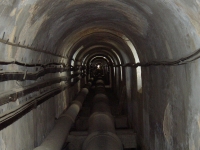
10. Differences
What are the differences with modern aqueducts?Here a set of questions with relevant answers, some of which are linked to related subjects as discussed in other places within this website www.romanaqueducts.info
Additional questions and remarks are most welcome via w.d.schram 'at' romanaqueducts.info
Questions
- What are the differences between ancient and modern aqueducts?
Answer
- The transport of Roman aqueduct water was based on gravity, there was almost no pressure involved like in pipes
- Often the water was transported in open channels, only in towns (lead) pipes were used. Note: in the eastern part of the Roman empire (Greece, Turkey etc) also pipes were used in aqueducts
- En route there were no storage facilities, apart from reservoirs in the Roman cities
- The water flowed constantly; only in some towns stopcocks were applied
- There was no quality control nor water purification
- The bulk of the water went to public fountains, just a small part was for personal hygiene or industry
- Measuring water consumption was problematic (see quinaria and calix)